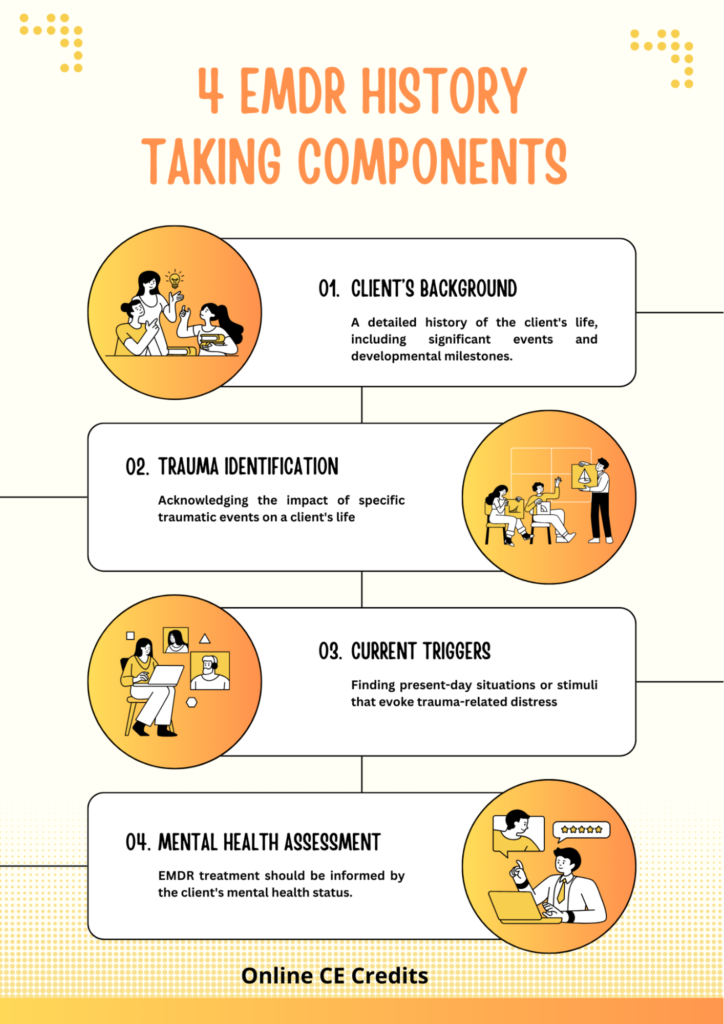Crafting effective EMDR (Eye Movement Desensitization and Reprocessing) questions is a skill that can significantly enhance the therapeutic process. It can lead to deeper emotional processing and healing for clients. While the EMDR protocol provides a structured approach, the flexibility within this framework allows therapists to tailor their questions that resonate with each client’s unique experiences. Understanding the art of asking the right questions can make a profound difference in the success of the therapy.
Also, completing an accredited course in EMDR for professional development enables you to identify what triggers a patient’s emotions and where they come from. From there, you can help the person identify and process their emotions positively.
The Art of Tapping into the Client’s Narrative
At the heart of EMDR therapy is the client’s narrative—their personal story that is often intertwined with traumatic experiences. The way a therapist engages with this narrative can either open doors to new understanding or inadvertently close them. The initial phase of EMDR, known as History-Taking, is crucial for building rapport and understanding the client’s experiences. Here, therapists gather information about the client’s past, present, and desired future.
4 EMDR History-Taking Components (Infographic)

However, this phase goes beyond simple data collection. It’s about listening deeply to the way clients describe their memories, emotions, and beliefs.
For instance, when a client speaks about a traumatic event, it’s important to pay attention not just to the content but to the language they use. Are they using certain words repeatedly? Do they seem stuck on specific details? This language provides clues about where they might be emotionally or cognitively “stuck.” A therapist might then ask, “When you think of that moment, what image or thought stands out the most for you right now?” This type of question helps to hone in on the aspects of the memory that are most charged with emotion, setting the stage for effective EMDR processing.
Balancing Structure With Flexibility
EMDR is often lauded for its structured approach, but within this structure, there’s a need for flexibility, especially when it comes to questioning. The Standard Protocol provides a series of steps and questions to follow, but each client’s journey through these steps is unique. This is where the therapist’s skill in crafting questions becomes particularly valuable.
For example, during the Assessment Phase, clients are asked to identify a negative cognition associated with a traumatic memory. The standard question might be, “What negative belief do you have about yourself when you think of that event?” While this is a good starting point, some clients may struggle to articulate clear negative cognition. In such cases, rather than pushing for an answer, a therapist might say, “If it’s hard to find the right words, can you share what feelings come up when you think about that event?” This invites the client to explore their internal experience without the pressure of finding the “right” answer, which can then naturally lead to identifying the underlying negative cognition.
Pacing and Timing: Knowing When To Ask
In EMDR, timing is everything. A question asked too soon can overwhelm a client, while a question asked too late might miss the emotional peak necessary for effective processing. This is particularly true during the Desensitization Phase, where clients process the traumatic memory through bilateral stimulation (e.g., eye movements).
Here, therapists must be attuned to the client’s responses—both verbal and non-verbal. If a client appears to be struggling with intense emotions, it might be tempting to jump in with a question to clarify or redirect. However, sometimes the best intervention is silence, giving the client space to process internally. When it does feel appropriate to ask a question, it should be one that helps the client stay with their experience without leading them away from it. A simple, “What do you notice now?” can be enough to keep the process moving forward without overwhelming the client.
Navigating Cognitive Interweaves: Gentle Nudging Towards Resolution
Cognitive interweaves are an advanced EMDR technique used when a client becomes stuck during processing. These are strategic interventions where the therapist introduces a piece of information or a perspective to help the client move past a block. The key to effective cognitive interweaves lies in how the therapist frames their questions or statements.
For example, if a client is stuck in a loop of self-blame, a cognitive interweave might involve gently challenging this belief. Instead of directly confronting the belief with a statement like, “It wasn’t your fault,” which might trigger resistance, a therapist might ask, “If someone else had experienced this, would you hold them responsible in the same way?” This type of question encourages the client to reflect and reconsider their belief from a different angle, without feeling confronted or judged.
The effectiveness of a cognitive interweave often hinges on the therapist’s ability to introduce new ideas subtly, allowing the client to come to their own conclusions. This requires a delicate balance—being supportive without leading and challenging without confronting.
Ignite Your Trauma Treatment With Core CEU Courses
Learn from experienced clinicians who specialize in trauma assessment, treatment, and prevention. Our online courses offer flexible learning at your own pace, allowing you to access valuable knowledge 24/7. Master techniques like clinically interviewing trauma clients without retraumatization, utilizing sensorimotor therapy for trauma recovery, and addressing personality and dissociative disorders stemming from trauma. Equip yourself to provide compassionate and effective care for clients navigating the complexities of trauma.
- Clinically Interviewing Trauma Clients Without Retraumatization
- Sensorimotor Therapy Techniques for Trauma Treatment: Practical Skills*
- Trauma Assessment and Treatment Planning: Ethical Considerations
- Personality and Dissociative Disorders: Trauma, Coping and Repair
- Helping Clients Recover Sexual and Relational Health After Sexual Trauma
Fostering a Collaborative Relationship
EMDR is a collaborative process. The therapist and client work together, each bringing their expertise to the table—the therapist with their knowledge of the EMDR protocol and the client with their intimate understanding of their own experiences. Effective questioning in EMDR respects this collaboration, inviting the client’s input and feedback at every step.
For instance, after processing a memory, a therapist might ask, “How does that feel different now?” rather than assuming a shift has occurred. This open-ended question allows the client to express their experience without feeling pressured to report progress. It also reinforces the collaborative nature of the work, reminding the client that their experience is central to the process.
Additionally, therapists can invite clients to be active participants in setting the agenda for sessions. This might involve asking, “What would you like to focus on today?” at the start of a session, or “Is there something specific you’d like to explore further?” during the session. These questions empower the client, fostering a sense of agency that is crucial for effective therapy.

Reflecting on Progress and Reinforcing Positive Changes
As therapy progresses, it’s important to help clients recognize the changes they are making, both big and small. During the Reevaluation Phase, therapists review previously processed memories to assess the client’s progress and determine next steps. Here, the questions asked can help clients consolidate their gains and reinforce positive changes.
Rather than simply asking, “How do you feel about that memory now?” A more effective approach might be, “When you think about that event now, what’s different for you?” This question not only checks in on the client’s emotional state but also encourages them to reflect on the progress they have made. This reflection is a crucial part of the healing process, as it helps to solidify the new, more adaptive beliefs and feelings that have emerged through EMDR.
Use the Power of the Right Question
The questions asked in EMDR are more than just prompts for discussion—they are tools that guide the client’s journey through their memories, emotions, and beliefs. Crafting the right question at the right time can make the difference between a client feeling stuck or experiencing a breakthrough. It requires a blend of clinical knowledge, intuition, and a deep understanding of the client’s experience.
As therapists continue to refine their questioning techniques in EMDR, they not only deepen the therapeutic process but also enhance their clients’ ability to heal and grow. The power of EMDR lies in its ability to transform lives, one carefully crafted question at a time. Expand your expertise in trauma therapy with our expert-led CE courses.